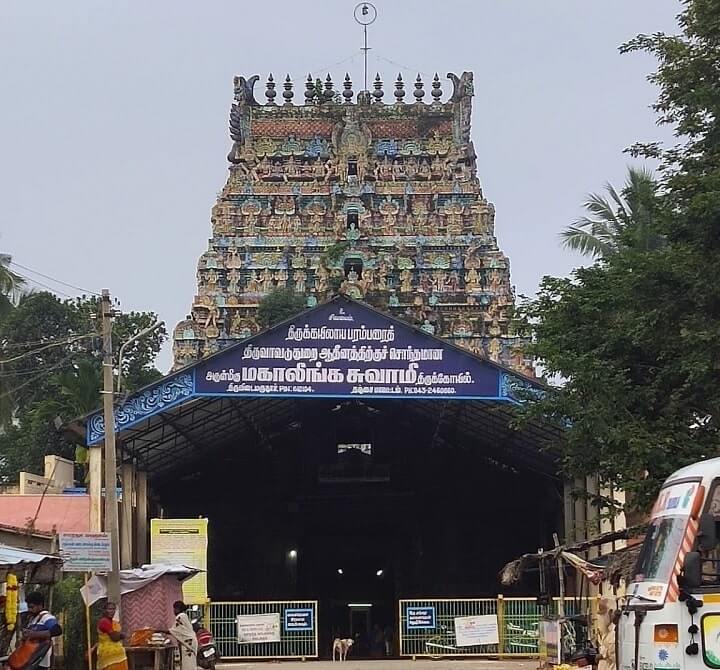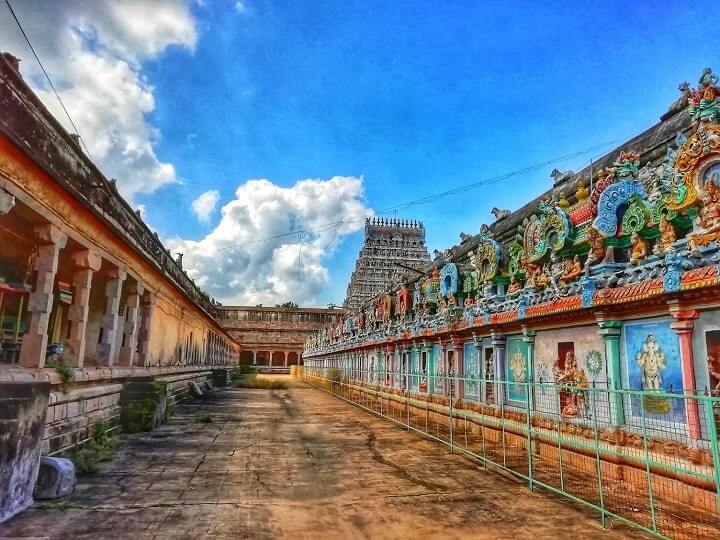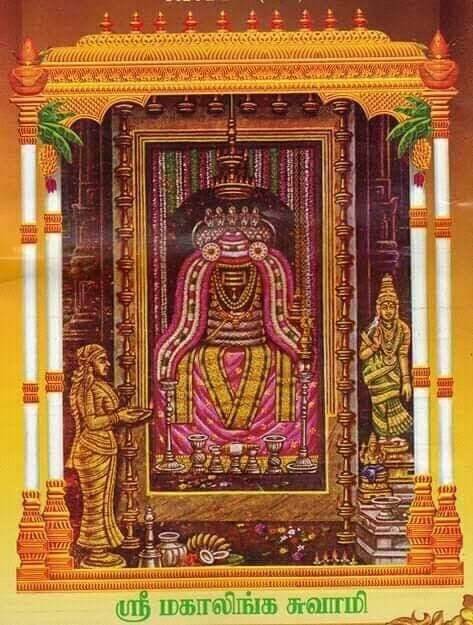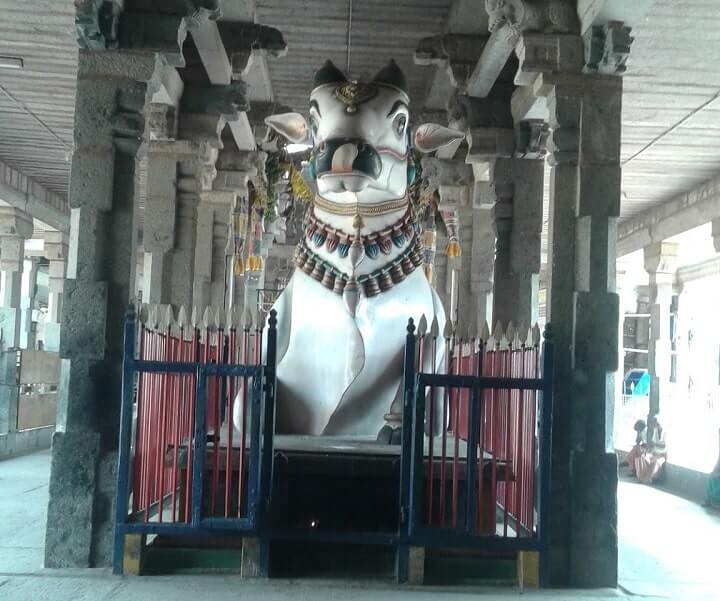- November 14, 2025
Last updated on September 24, 2025

| Sivastalam Name | Arulmigu Mahalingeswarar Temple, Tiruvidaimarudur |
|---|---|
| Deity (Main) | Mahalingeswarar, Mahalingam |
| Goddess | Bruhath Sundara Rusambikai, Nanmulaianayaki |
| Sthala Vriksham | Marudha Tree |
| Theertham | Ayiravanthurai, Cauvery, Karunya Amrita Theertham |
| Ancient Name | Madhyarjunam |
| Town | Tiruvidaimarudur |
| District | Thanjavur |
Thennādudaiya Sivanē Pōtri
Ennāttavarkkum Iraivā Pōtri
The temple’s history dates back to when Sage Agastya arrived in Thiruvidaimarudur with other sages. He performed severe penance, meditating on Goddess Uma (Parvati). Pleased by his devotion, Uma Devi appeared before him and the sages. The sages, after duly worshipping the Goddess, expressed their desire to behold Lord Shiva.
To fulfill their wish, Goddess Uma herself undertook a rigorous penance, meditating on Lord Shiva. Moved by her devotion, Shiva appeared before both Uma and the sages at this very spot.
After granting them his divine vision, Lord Shiva himself began to worship the Jyotirlingam (Linga of Light). Astonished, Goddess Uma asked, “Lord, it is customary for Brahma and others to worship you. Why are you worshipping yourself?”
Shiva replied, “Oh Uma, I am both the worshipper and the supreme being who accepts the worship. The reason I am worshipping myself is that these sages momentarily forgot to worship me. Hence, I am performing this worship.” From that day forward, the sages began worshipping the Lord according to the Kamika Agamam (a set of Shaiva scriptures), attaining great blessings, as narrated by the temple’s history.

The Mahalingaswamy Temple holds immense significance. It’s the 30th Thevara Padal Petra Sthalam (temple praised in Tevaram hymns) on the southern bank of the Cauvery River, and the 93rd among the 276 Shiva temples glorified in the Tevaram hymns.
The temple boasts three circumambulatory paths (prakarams), and circumambulating each one is considered highly sacred and bestows unique merits.
The Aswameda Prakaram
This is the outermost circumambulatory path. Walking around this prakaram is believed to grant the same spiritual benefits as performing the Aswamedha Yagam (horse sacrifice), a powerful ancient ritual.
The Mudi Prakaram
This is the second, middle circumambulatory path. Circumambulating this prakaram is considered equivalent to circumambulating Mount Kailash, the sacred abode of Lord Shiva.
The Pranava Prakaram
This is the third, innermost circumambulatory path. Walking around this prakaram is believed to lead to moksha (liberation).
Unique Features
The deity in Thiruvidaimarudur is a Svayambhu Murthy, meaning it is a self-manifested form of the Lord. The Mookambigai Shrine within this temple is particularly famous. Located on the south side of the Amman (Goddess) shrine, it’s notable that Mookambigai shrines are found in India only in Thiruvidaimarudur and Kollur, Karnataka.

This temple has a fascinating connection to the life of Varaguna Pandyan, a king of the Pandya kingdom. One day, while hunting in a nearby forest, the king’s horse accidentally trampled and killed a Brahmin who was sleeping on the path. This act caused the king to be afflicted with Brahmmahatthi dosha (the sin of killing a Brahmin), and the Brahmin’s spirit also began to haunt him.
As a devout devotee of Lord Shiva, Varaguna Pandyan sought refuge in Lord Somesundarar of Madurai, praying for deliverance. Lord Somesundarar appeared in the king’s dream and instructed him to go to Thiruvidaimarudur and worship him there.
The king was anxious about entering Thiruvidaimarudur, which was in the enemy Chola kingdom. However, soon after, he received news that the Chola king had invaded the Pandya kingdom. Varaguna Pandyan went to war, defeated the Chola king, and pursued him all the way to the Chola country. This turn of events led him directly to Thiruvidaimarudur. He entered the temple through the main eastern gateway to worship the Lord.
The Brahmmahatthi and the Brahmin’s spirit, which had been clinging to the king, dared not enter the sanctified temple and waited outside, hoping to re-afflict him upon his return. However, in a divine voice, Lord Shiva commanded King Varaguna Pandyan to exit through the western gateway, thus blessing him and freeing him from the dosha.
The king, now free from the Brahmmahatthi dosha, returned to his Pandya kingdom. This incident is why, even today, devotees entering this temple traditionally enter through the main eastern gateway and exit through the western gateway near the Amman shrine.
The Vinayagar (Ganesha) in this temple is known as Andavan Vinayagar because he worshipped Lord Shiva and ruled so that all beings would prosper.
It is believed that Lord Shiva himself performed self-worship here to instruct the Devas on the proper methods of worship. This temple is called a Mahalinga Sthalam because other important parihara sthalams (remedial temples) are located nearby:
Uniquely, the rituals for Lord Mahalingam are performed before those for Vinayagar at this temple.
This temple is associated with the Moon (Chandra) and is also considered a Nakshatra Dosha Nivarthi Sthalam (a place for remedying astrological afflictions caused by stars), as 27 stars worshipped here and received blessings. You’ll find 27 Lingams dedicated to the 27 stars in the Adalvallan Mandapam.
Thiruvidaimarudur is considered equivalent to Kashi in terms of sanctity. Those who circumambulate the Aswamedha Thiruchutru (the inner circuit of the first wall) are said to attain the benefits of performing the Aswamedha Yagam. Similarly, circumambulating the Kodumudi Thiruchutru grants the benefits of circumambulating Mount Kailash.

Four Vinayagar temples are located at the corners of the four streets where the temple chariot traditionally runs. With the Vinayagar temple at the chariot stand, Vishwanathar temple on the East Street, Rishipurishwarar temple on the West Street, Atmanathar temple on the South Street, and Sokkanathar temple on the North Street, all encircling the central Mahalingeswarar, this temple is also known as a Panchalinga Sthalam (a temple with five Lingams).
This temple has seen renovations and patronage from various dynasties, including the Cholas, Pandyas, Nayaks, and Marathas, with numerous Chola-era inscriptions still visible.
Special Prayers: The Mookambigai shrine is especially significant, drawing a large number of devotees. Married women fervently pray to this Goddess for problem-free pregnancies and safe deliveries, making this a highly revered spot for such requests.
It is a visible truth even today that devotees who properly circumambulate the temple’s large prakaram and worship the Moolavar (presiding deity) are relieved from mental instability, psychological ailments, madness, and other major diseases and sins, achieving all the benefits they desire.
Worshipping the Moolavar, Mahalinga Swamy, alleviates mental distress. Those seeking boons for marriage or children also visit and pray here. Devotees who worship Lord Shiva at this temple attain peace of mind. Furthermore, if you pray here for employment opportunities, business growth, or career advancement, the Lord is sure to grant your wishes.
Devotees can perform Abhishekam (ritual bathing) for the Lord with milk, curd, panchamirtham (a mixture of five ingredients), rice flour, honey, rosewater, tender coconut water, sandalwood paste, sacred ash, mango powder, and turmeric powder. Additionally, offerings such as a dhoti for the Lord and a saree for the Goddess can be made. Devotees also offer Annadanam (food charity) to visitors and distribute prasad (sacred food offerings) after Nivedyam (offering to the deity). Regular Abhishekam and Aradhanai (worship) services are also performed. Those who are able can also contribute financially to the temple’s renovation and maintenance.
Thai Month (Jan-Feb): Thaipusam – A 10-day Brahmotsavam (grand festival) featuring daily processions of the deity on various vehicles in the mornings and evenings. The festival concludes on the 10th day with Theerthavari (holy bath).
Vaikasi Month (May-June): Vasantha Utsavam (Spring Festival) – Another 10-day festival featuring special celebrations like Thirukkalyana Utsavam (divine marriage), Amman Thapasu (Goddess’s penance), and Amman Thannai Thanai Utsavam (Goddess’s self-celebration).
Thiruvathirai, Aadi Pooram, and Karthigai are also considered highly auspicious days at this temple.
During monthly Pradosham days, the temple sees a huge influx of devotees.
Special Abhishekam and Aradhanai are also performed on major annual festivals like Deepavali, Pongal, and Tamil & English New Year.
Arulmigu Mahalingeswarar Temple is open:
Tiruvidaimaruthur Temple Contact Number: +914352460660
Arulmigu Mahalingeswarar Temple,
Thiruvidaimarudur,
Thiruvidaimarudur Post,
Thiruvidaimarudur Taluk,
Thanjavur District,
PIN – 612104.